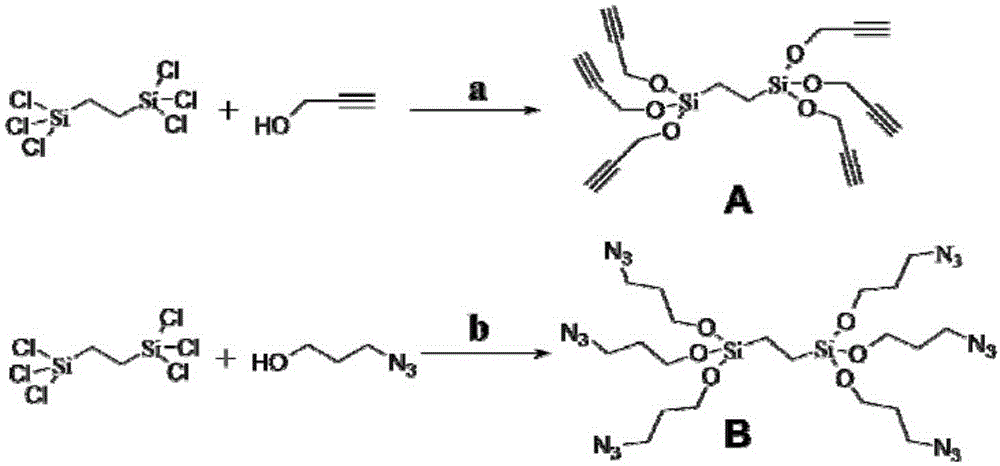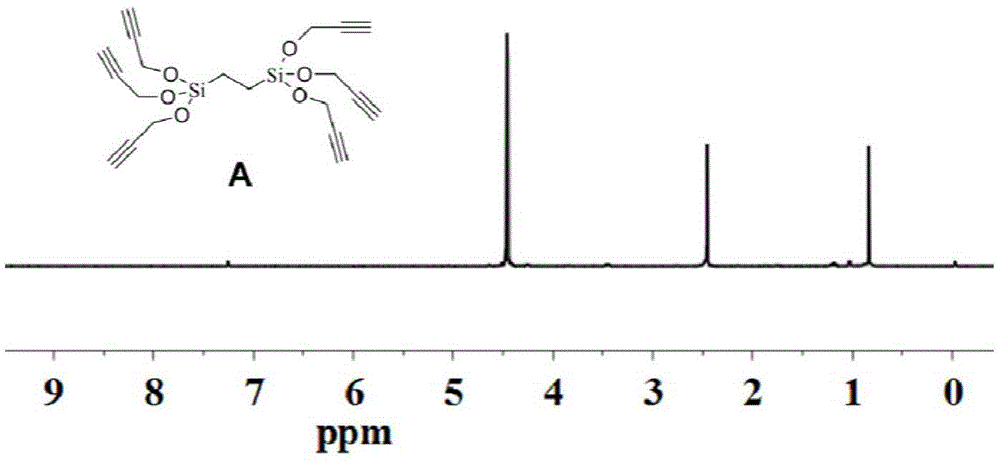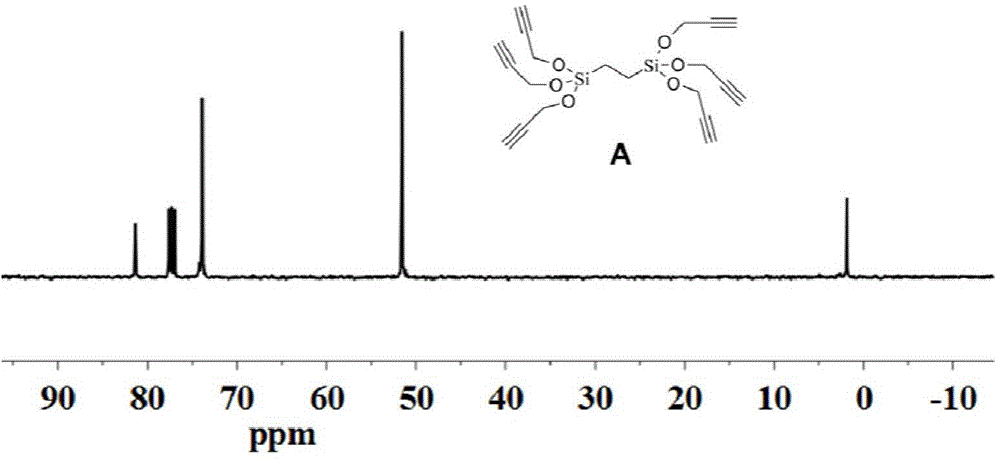Double-component crosslinking agent, preparation method and applications thereof
A cross-linking agent and two-component technology, which is applied in the field of two-component cross-linking agent and its preparation, can solve problems affecting device performance, high curing temperature, etc., and achieve the effect of simple and effective method, low cost and easy raw materials
- Summary
- Abstract
- Description
- Claims
- Application Information
AI Technical Summary
Problems solved by technology
Method used
Image
Examples
Embodiment 1
[0063] Example 1. Preparation method of novel crosslinking agent
[0064] This embodiment provides a method for preparing a novel crosslinking agent. The crosslinking agent includes a silane compound containing an alkyne bond and a silane compound containing an azide group. Its structure is shown in the following formula (I). figure 1 .
[0065]
[0066] 1.1. Preparation of silane compounds containing acetylenic bonds (A)
[0067] The structural formula of the acetylene bond-containing silane compound A is as follows, and the preparation method is as follows:
[0068]
[0069] see figure 2 Is the hydrogen nuclear magnetic resonance spectrum of silane compound A containing acetylenic bond ( 1 H-NMR); image 3 Is the carbon NMR spectrum of silane compound A containing acetylenic bond ( 13 C-NMR); Figure 4 This is the infrared absorption spectrum (FT-IR) of the acetylene bond-containing silane compound A.
[0070] The preparation method is as follows: add propynol (1.12g, 21.0mmol) and...
Embodiment 2
[0081] Example 2: Infrared absorption spectrum, differential calorimetric scanning analysis and thermogravimetric analysis of cross-linked polystyrene material
[0082] The crosslinking agent used in this example is the novel crosslinking agent prepared in Example 1, blended with polystyrene; the weight ratio of polystyrene, acetylene bond-containing silane compound, and azide group-containing silane compound is 20:10:10, the solvent is dichloromethane) After spin-coating on the silicon wafer, the infrared absorption spectrum is characterized; the solid obtained after the mixed solution is vacuum dried is used for differential calorimetric scanning analysis and thermogravimetric analysis.
[0083] Picture 8 The infrared absorption spectrum of the thermally crosslinked polystyrene material after spin coating is given, and the spectrum is 2100cm -1 And 3290cm -1 The absorption peaks of are the characteristic absorption peaks of azide group and acetylene bond, respectively, indicatin...
Embodiment 3
[0084] Example 3. Infrared absorption spectrum, differential calorimetric scanning analysis and thermal analysis of crosslinked polymethyl methacrylate material Reanalysis
[0085] The crosslinking agent used in this example is the new crosslinking agent prepared in Example 1, blended with polymethyl methacrylate; polymethyl methacrylate, acetylene bond-containing silane compound, azide group-containing The weight ratio of the silane compound is 20:10:10, and the solvent is dichloromethane). After spin-coating on the silicon wafer, the infrared absorption spectrum is characterized; the solid obtained after the mixed solution is vacuum dried is used for differential calorimetric scanning analysis and thermal analysis. Re-analyze.
[0086] Picture 11 The infrared absorption spectrum of the thermally crosslinked polymethyl methacrylate material after spin coating is given, and the spectrum is 2100cm -1 And 3290cm -1 The absorption peaks of are respectively the characteristic absorp...
PUM
 Login to View More
Login to View More Abstract
Description
Claims
Application Information
 Login to View More
Login to View More - R&D
- Intellectual Property
- Life Sciences
- Materials
- Tech Scout
- Unparalleled Data Quality
- Higher Quality Content
- 60% Fewer Hallucinations
Browse by: Latest US Patents, China's latest patents, Technical Efficacy Thesaurus, Application Domain, Technology Topic, Popular Technical Reports.
© 2025 PatSnap. All rights reserved.Legal|Privacy policy|Modern Slavery Act Transparency Statement|Sitemap|About US| Contact US: help@patsnap.com



